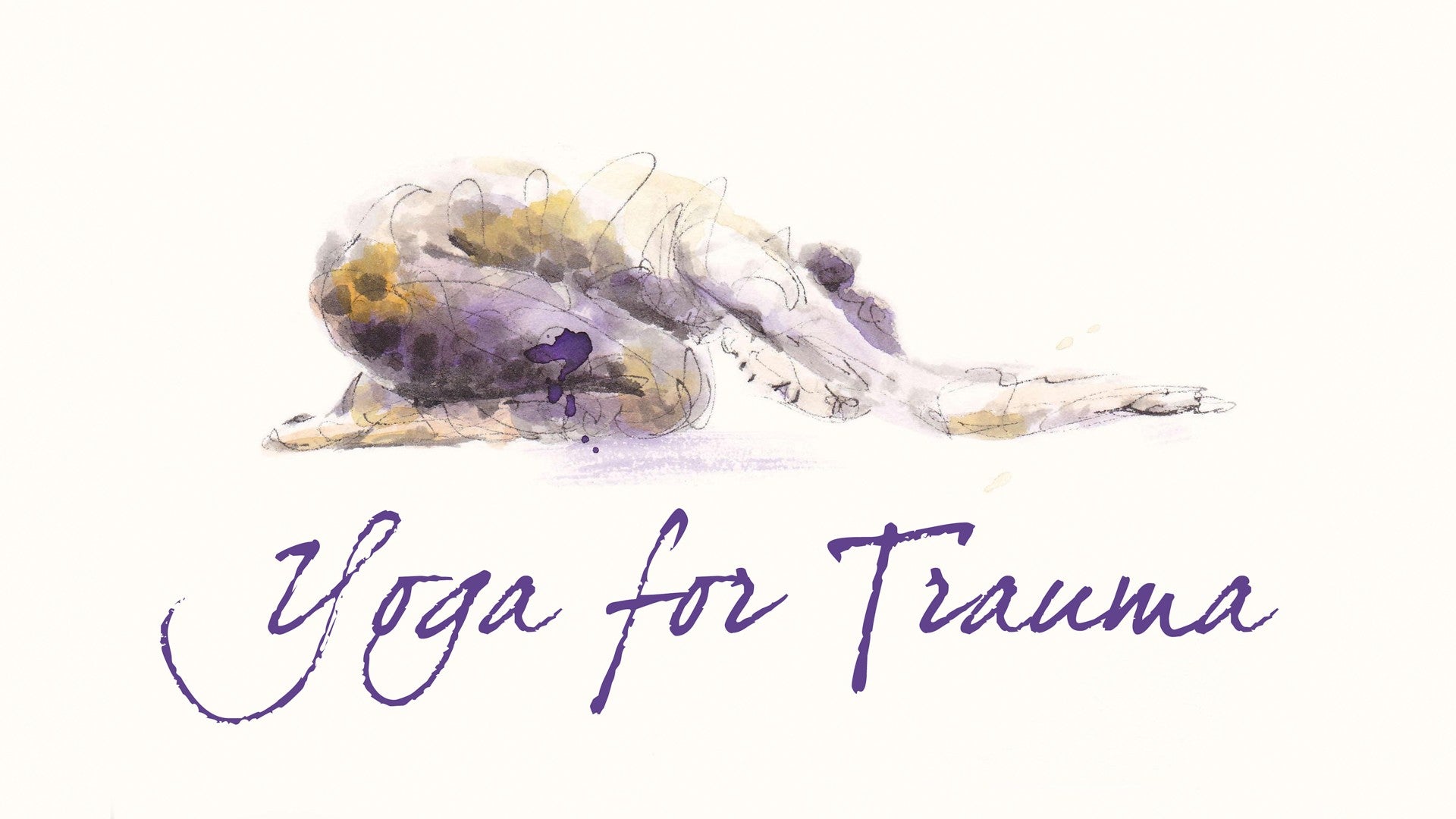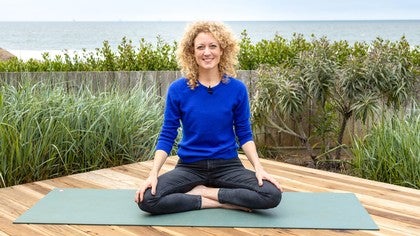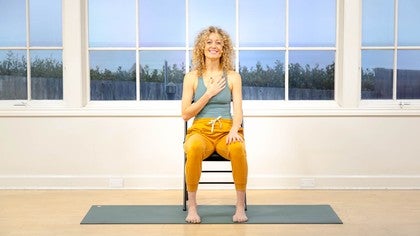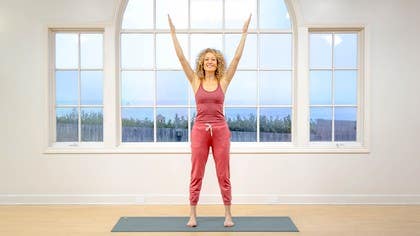Description
About This Video
Transcript
Read Full Transcript
Hi there, I'm Kira. I use the pronouns of she and her, and I'm a licensed psychotherapist as well as a yoga teacher of many years. I absolutely believe in the healing and transformative power of yoga, as well as other ancient holistic practices. And I think it's pretty amazing when we can understand a little bit of the brain and body science to help us create better roadmaps in order to help us regulate in our lives. And by self-regulate, I mean the ability to lift ourselves up when we're feeling really low, or to calm ourselves down when we're really activated. I also think it's important to create roadmaps in our lives for not just survival but also for thriving. In this talk, I want to give you a little bit of information of what I and my other colleagues in the field of mental health believe to be an essential aspect of healing and transforming trauma. It's a part of our autonomic nervous system that has been evolving towards growth, health, and restoration for millions of years. And it's not just about moving us towards surviving, but also towards that state of thriving and joy and connection. It's called the social engagement system. Now, if you haven't watched my What is Trauma? from season one, you might go back and look at it because it gives a really good in-depth explanation of how trauma impacts our body and what's needed in order to heal and move through that. But I'm going to give you, just for context, a quick overview of the autonomic nervous system. So you know what we're talking about, just in case you haven't seen it. The autonomic nervous system is generally our superhighway of energy and information that's always flowing between head, brain, and the body. It's working 24-7 at an unconscious level and its main job is our survival. So even without thinking, at an unconscious level, 24 hours a day, 7 days a week, the autonomic nervous system is working to coordinate our metabolic functions and to make sure that we are moving towards safety. Now, it was originally thought to be a binary. It was either thought of as fight or flight or rest and digest, or another way of thinking about it is like the gas pedal, the sympathetic nervous system, or the brake pedal, the parasympathetic nervous system. More recently, science has substantiated what I believe yogis to have known for thousands of years is that our system is more complex. It largely, thanks to the research of Dr. Stephen Forges and his Pauli Bagel theory, we understand that now the autonomic nervous system actually has three pathways to responding to signals of stimulus in our environment, both within and around us. One of the pathways is that gas, is that sympathetic fight-flight system, and the other two pathways are actually part of the braking system or the ways our bodies slow down. One of the pathways or that brake descends all the way down into our guts and it's the part that acts more like an emergency brake, freezing us when we need, and the other part is more nuanced and finesses the system and allows us to stay in connection. This is what we're talking about with the social engagement system. Now it's important to know that this brake system is mediated by one of the longest nerves that runs through the body. It's called the vagus nerve. Vagus from the root in Latin means to wander and that it absolutely does. It starts at the base of the skull and it goes all the way down. I think of it like roots of a plant or a tree that extend out in many directions. It goes below the diaphragm into the body and up all the way through the face. One of the coolest aspects of this nerve, at least in my mind, is that 80% of its fibers are feeding from the body to the brain. Only 20% is going from the head brain back to the body. This is important because it really substantiates that what we feel in our systems, how we interact at a non-verbal kind of like below the layer of the thought process, really impacts not only our sense of safety, but also who we are in the world. The pathway of this brake system that goes all the way down below the diaphragm is, evolutionarily speaking, the oldest aspect of our nervous system. It goes back 500 million years ago that we still have as a part of our system. When it's working well, it helps with rest, it helps with digestion. When there's a perception of life-threatening danger, however, it acts like an emergency brake, very quick draining the energy from the system and moving us physically, energetically, emotionally out of connection with our environment and our relationships. It essentially freezes us. Now, the upper part of these vagal pathways that go above the diaphragm is the newest part of the autonomic nervous system. This is what we're talking about when I mentioned social engagement. Let's track this neural pathway system together with our own hands. Bring your hands together and make sure there's a little circulation and connection, and then take your hands to the base of the skull. It's here that this 10th cranial nerve comes out, and then track the hands down through the neck and the throat, through the larynx and the pharynx where we make vocalizations, we speak, we sing from. Then bring the hands down into the lungs.
This vagal pathway, its name is the ventral vagal, goes right into the lungs. We're not only able to control our breathing at an unconscious level, which is happening all the time, but as yogis know, we can control this consciously, the breathing patterns. It also goes over and innervates into the pacemaker of the heart and helps control a gentle nuanced break for the heart, keeping the heart rate under 72 beats per minute. This ventral vagal system is able to gently slow or release the breaks on the heart, partially because it has something called myeline, all coating it. It's a fatty lipid that makes it move and send connections through its pathway instantaneous, almost like a fiber optic cable. I think of how this break works on the heart, how the ventral vagal nerve works on the heart, almost like really finely tuned bike. If you think about the handlebars of a bike, when you're going down a hill and you're going a little too fast, you can gently put the brakes on, so you can still be coasting, still be riding your bike, but it's not going to be out of control. Then when the coast is clear and everything's easy and it's fun, you can let all the brakes off and go for it. Depending on what other cues from our environment and inside of our bodies, it's doing this gentle break and release, break and release and keeping us in connection. This vagal pathway also extends up through our throat, as I mentioned before, and into the face. It goes into the facial muscles, it goes deep into the inner ears, it goes into the mouth, the eyes, the nose. What's happening up here? These are all the ways human animals interact with our environment in order to have more connection. These are the ways through our gaze, through what we hear in the world, the sounds we make with our voice, the facial expressions, the body language that we use, how close we get to one another or how far away we are from one another. If we turn and don't look at someone or we are actually more face-to-face in connection, these are all ways we are making and offering and taking in cues around our safety. The cues that we make and take in impact one another. If I go home and my roommate happens to have a flat, grumpy affect and is only responding to me with one-word runs and maybe turning their gaze away from mine, I'm going to feel something in my body. Something might either be constricted, and depending on my history and background, I might either get kind of scared and have to leave the room or I might feel kind of defensive or I might actually be like, oh, that's their thing. I'm going to give them some space and everything's all right. Now, that's going to be a different response in my body if I'm with somebody with whom I feel a lot of trust and love and care with. So if someone, I think of when my grandmother was like who I really got a sense of just like accepted me however I was and whatever state I was, there was so much acceptance and a sense of belonging there, my whole system would settle with that. And as I could receive her gaze or her close touch to me or even the tone of her voice, I had more space in my system. When we are able to detect cues of safety, we get more space and fluidity. Oftentimes the tone of our voice has a greater range. Our movements get more fluid and possibly bigger. And we even have more capacity to kind of like have things be pinged in us, be aroused or excited or a little irritated and come back and stay in connection when we have a greater sense of safety within us. Now, this isn't new. This has been evolving for millions of years. We've actually been evolving and are now hardwired for connection when we come into the world. The sense of bonding is essential for survival. Think about human babies when they come in. In order to be taken care of, we can't care for ourselves as infants. We need another person to rock us, our caregivers to turn towards us and to attend to us. And in return, babies, human babies and infants and other mammals, babies, turn towards their caregivers and they give responses back, which then regulates the caregivers. So if there's a baby crying and I rock it, I might feel agitated while it's crying. It might feel agitated. We rock it. And then it starts to soothe. And as I notice it soothes and it makes contact with me, I'm going to soothe in my heart rate palms. And now for those of you listening to this that maybe didn't get the most ideal amount of co-regulation soothing or attachment early on, please do not worry, right? Our systems have something called neuroplasticity. It is always changing and shifting depending on what we experience.
And that's why this is so essential that we spend some time with our social engagement system learning about what it is, kind of what the map is to our own like okay-ness in the world and ways that we make that happen with others. So I'm going to ask you right now and maybe you get out a piece of paper and you pause this talk and come back to it in a few moments or maybe you think about some of these questions in journal afterwards. But where are the spaces in your life? With whom? Do you get those signals of safety and okay-ness? When you're in those spaces, where and with whom? Maybe it's the sounds or the environment. Can you feel like you are settled enough to be okay? Self-regulation is not about perfection. It's not about sparkly unicorns and like the most like living your best self all the time. It's not about that at all. It's really just being able to stay in connection with our longer term goals and principles and be able to feel a sense of that it's all right to be in our own body and being. So as you think about this, I'm going to encourage you to think about all the ways that our social engagement system picks up these cues. What are the sounds that you love? I'm right here next to the ocean. I can hear the crashing of it behind me and it's actually giving me more or a greater sense of grounding. When I was younger, I really loved punk rock and going to those shows actually gave me a sense of belonging and like my vitality and that was a way I regulated. So what do you see? What sort of colors? What textures do you love? And when you look at those and you might even glance into your environment right now and see if you can pick up any of those. How does that impact the musculature, your breathing, your sense of being here? Thinking about the environment and of course the relationships. With whom do you feel kind of more yourself, more okay and affirmed? Belonging is not just a nice thing that would be great if we were like in the in crowd. It's not about that. It's actually an essential part of our safety. It's almost as important to our survival as human beings as water and food and oxygen. Research has shown that other mammals, including humans, if they didn't get that connection, that attachment, that sense of validation early on, their brains do not develop as strongly and oftentimes they don't thrive. And I'm talking about pretty extreme cases here because it really just takes one relationship in our life to be able to develop a sense of okayness and resilience in the world. But we need this sense of safety to feel okay, to feel safe enough to self-regulate. If you don't feel safe, if there's a tiger in the room or anything that will represent as a tiger, I'm not going to be able to stay super grounded and centered because part of my body and physiology just needs to run away or is ready to fight, right?
We need safety to self-regulate. And if you can't find that, that's a problem. So I want you to take a moment right now, actually, and just try to bring up a moment where you didn't belong, where you didn't feel like you fit in or were validated or affirmed in a space, right, if you can. For some of you, that's really easy to access. And for others of you, it's a little bit harder depending on your relationship to kind of like power and privilege. And just notice what happens in your body as you even think about that. Don't choose the hardest time, right? It shifts. I'm going to suggest that our society, cultures, communities are always sending us unconscious cues of how we either belong or we don't, right? Either safe or kind of not safe. And I'm going to speak from my own perspective in the U.S., but the Western white dominant culture here does not equally give signals of safety to all beings. Therefore, the ability to self-regulate is more of a privilege depending on how much you belong in dominant culture rather than a basic right. If we are really serious about healing trauma, and I'm guessing that if you've made it this far in this talk in season three of Yoga for Trauma, you're pretty serious about healing trauma. We have to consider not just our individual experience of healing and wellness and well-being, but we have to actually think about our interconnectedness or interdependence with all other beings. Because if there is a big portion of our population that is being told that they are not worthy because or don't belong because of race, gender identity, sexual orientation, size of body, age, the ability to move body or not in these dominant culture spaces, then we are essentially othering other people. We're dehumanizing them, and that is trauma. And as Yoga says, we are all connected. We are all one. I fully believe that. So that means we need to start showing up for one another in the ways that we can. So I get that we are all in different stages of healing. That is absolutely okay. Some of us have just begun this practice and only have the room at this moment to be focusing on how to make it through the next day and next moment. And that's where you are at this moment, and that's okay. Others of us, because of our lived experiences, have been historically holding the burden of institutional and oppression and violence in our own bodies. And right now, there might not be any more room for anything besides rest. And of course that is okay. But I want to suggest that it's important for us to be just holding our identities as not just individual, but as interconnected because we do co-regulate each other. And when we can take action, both confronting our own suffering on our mat, being able to increase our capacity to hold for the hard spaces and really learn how to turn towards them with compassion, with listening, with validation of other people's experiences and their humanness and their broken-heartedness, then we have room for transformation, then we have room for joy, then we have the energy to step out into sustainable activism in whatever ways that shows up for us. But holding that interdependence is also a key of healing because you are not alone, and none of us made it through this life by ourselves, right? I'm so glad you're here, and this is why, this is what this whole season is about. It's about learning these new, maybe more detailed roadmaps to our own regulation, how we regulate each other, just even the awareness that we do it, and also recognizing our interdependence. So if this resonates with you, I'm so glad. You might even go back and watch it again as there's a lot of content here, right? Send it to a friend or maybe write to me in the forum on the site. Either way, I just wish you so much wellness on this path. Thank you for being here and for doing this work.
Yoga for Trauma
Comments
You need to be a subscriber to post a comment.
Please Log In or Create an Account to start your free trial.













